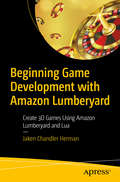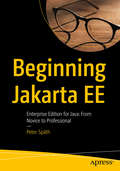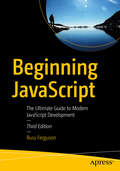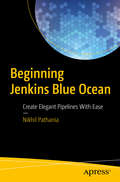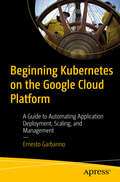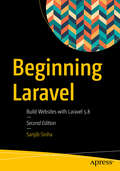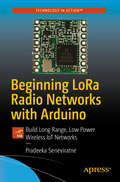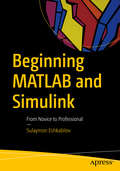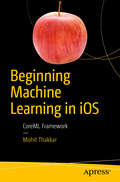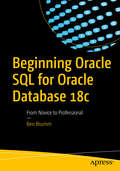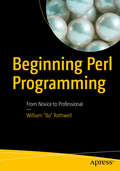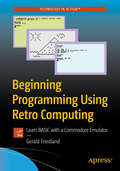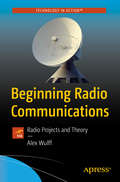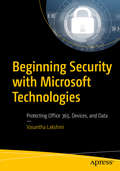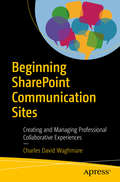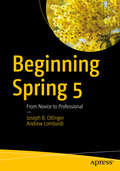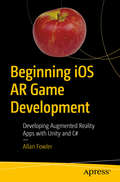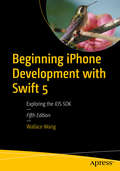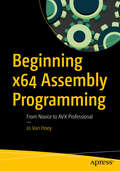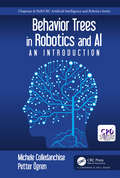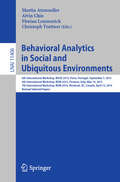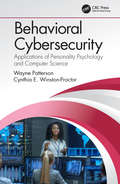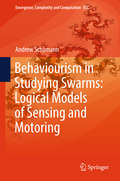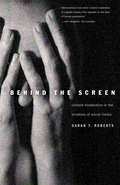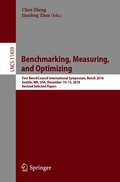- Table View
- List View
Beginning Game Development with Amazon Lumberyard: Create 3D Games Using Amazon Lumberyard and Lua
by Jaken Chandler HermanCreate stunning 3D games in a short amount of time using Amazon Lumberyard, a free and exciting game development platform. This book is a ground-up, out-of-the-box tutorial on 3D game development and programming with Lua and Amazon Lumberyard with little or no game development experience required. Beginning Game Development with Amazon Lumberyard walks you through the user interface of the Amazon Lumberyard engine; teaches you how to develop detailed terrain using heightmaps, megatextures, weather, and vegetation; and takes you through exporting the game for distribution. The book will show you how to create a player as well as enemies while not getting bogged down with third-party tools for animation or model creation. You will also work with simple physics, colliders, meshes, weather generation, Lua scripting, user interface development, and much more.By the end of the book, you will be able to create many different types of video games using the Amazon Lumberyard engine and even have a completed project ready to release or put in your portfolio.What You Will LearnDiscover the mechanics and terminology of game developmentFamiliarize yourself with the Amazon Lumberyard game engine in detailModify game scripts using the Lua languageDiscover how to optimally structure game layersWho This Book is ForDevelopers, programmers, and would-be game designers who have long wanted to dip their toes into the world of game development but have found other game engines and platforms to have too high a barrier to entry.
Beginning Jakarta EE: Enterprise Edition for Java: From Novice to Professional
by Peter SpäthBuild Java-based enterprise applications using the open source Eclipse Jakarta EE platform. This feature-packed book teaches you enterprise Java development top to bottom. It covers Java web-tier development using servlets, JavaServer Faces (JSF), RESTful applications, and JSON. You’ll also cover Java data-tier development using persistence and transaction handling, messaging services, remote procedure calls, concurrency, and security to round out a complete Java-based enterprise application.Step by step and easy to follow, Beginning Jakarta EE includes many practical examples. Written by a Java expert and consultant, this book contains the best information possible on enterprise Java technologies. You’ll see that Jakarta EE is the next evolution of Java EE 8 and how it is one of the leading Java platforms for enterprise application development. What You Will LearnBuild enterprise Java applications using Jakarta EESet up your development environmentCreate page-flow web applications with JSF Write single-page web applications with REST and JSONPersist data using JPA in Jakarta EEBuild enterprise Java modules using EJBs and CDI Work with transaction engines using JTA Secure, log, and monitor your Jakarta EE applications Who This Book Is ForBeginning Java EE application developers with some experience of Java 8.
Beginning JavaScript: The Ultimate Guide to Modern JavaScript Development
by Russ FergusonDiscover everything you need to know to get up-to-speed with JavaScript development and add dynamic enhancements to web pages. This completely updated third edition reveals how the code works and when to use closures, constants, and execution content. <p><p> Starting with the basics, you’ll see how to employ prototypical inheritance, as well as memory management, variable hoisting and event bubbling. Also covered is an introduction to Node.js and package managers, key to understanding the tools necessary in front-end development and how they are used with current JavaScript frameworks. <p><p> JavaScript is one of the most important technologies on the web, providing the means to add dynamic functionality to your web pages and serving as the backbone of working with frameworks like Angular and React. Beginning JavaScript, Third Edition will take you from being a JavaScript novice to working freely with this important technology - begin your JavaScript journey today! What You'll LearnConstruct good JavaScript syntax following modern coding practicesUse JavaScript to communicate with the server and retrieve dataDynamically manipulate markup, validate forms and deal with imagesDebug applications using features inside the browserUse TypeScript to bring strong typing to the languageWho This Book Is For Beginner to intermediate developers with a basic knowledge of front-end programming who are looking for a deeper understanding of how JavaScript works in the browser and how to answer questions in an interview. <P><P><i>Advisory: Bookshare has learned that this book offers only partial accessibility. We have kept it in the collection because it is useful for some of our members. Benetech is actively working on projects to improve accessibility issues such as these.</i>
Beginning Jenkins Blue Ocean: Create Elegant Pipelines With Ease
by Nikhil PathaniaDive deep into Jenkins Blue Ocean and discover how easy creating a pipeline can be. You’ll see how Blue Ocean provides a better user experience when designing, running, and visualizing pipelines. This book shows you its intuitive user interface and its powerful pipeline editor and how this makes it a tool for everyone.Beginning Jenkins Blue Ocean starts with an introduction to Blue Ocean, followed by a step-by-step guide on how to set it up. You’ll learn how to create a pipeline for every branch and pull request on your Git, GitHub, and GitLab repositories. You'll experience the improved pipeline visualization and log diagnosis features in Blue Ocean. Later you will go beyond the visual pipeline editor to learn the declarative syntax and gain better control over your pipelines. Then, you'll take a look at some tools to enable you to write pipeline code in the declarative syntax. You will also learn to extend delivery pipelines with Jenkins shared libraries.What You Will LearnDiscover Jenkins Blue Ocean and how to use itCreate elegant pipelines using the visual pipeline editorWork with the declarative pipeline syntax Use tools that help you write declarative pipeline code Extend pipelines with Jenkins shared librariesVisualize pipelines from classic Jenkins in Blue OceanConfigure and view test results in Blue OceanAccurately diagnose pipeline failures using improved pipeline visualizationCreate multibranch pipeline projects for your Git, GitHub, and GitLab repositoriesWho This Book Is ForThose new to Jenkins who are looking for an easy introduction. The book will also be useful for readers familiar with classic Jenkins and would like to learn Jenkins Blue Ocean.
Beginning Kubernetes on the Google Cloud Platform: A Guide to Automating Application Deployment, Scaling, and Management
by Ernesto GarbarinoUse this beginner’s guide to understand and work with Kubernetes on the Google Cloud Platform and go from single monolithic Pods (the smallest unit deployed and managed by Kubernetes) all the way up to distributed, fault-tolerant stateful backing stores.You need only a familiarity with Linux, Bash, and Python to successfully use this book. Proficiency in Docker or cloud technology is not required. You will follow a learn-by-doing approach, running small experiments and observing the effects.Google open sourced Kubernetes in 2015 and now it is the industry standard in container orchestration. It has been adopted by all leading vendors of cloud, on-prem, and hybrid infrastructure services: Microsoft (Azure AKS), Amazon (AWS EKS), IBM (IBM Cloud Kubernetes Services), Alibaba Cloud (ACK), RedHat (OpenShift), and Pivotal (PKS). Even though Kubernetes is offered by all of the market-leading cloud providers, the Google Cloud Platform (GCP) offers an integrated shell (Google Cloud Shell) and a $300 credit to get started, which makes it the ideal platform to not only learn Kubernetes but also to implement final production workloads. What You Will Learn Set up a Kubernetes cluster in GCPDeploy simple Docker images using monolithic PodsArrange highly available and highly scalable applications using DeploymentsAchieve zero-downtime deployments using the Service controllerExternalize configuration using ConfigMaps and SecretsSet up batch processes and recurrent tasks using Jobs and CronJobsInstall horizontal (sidecar pattern) services using DaemonSetsImplement distributed, stateful backing stores using StatefulSets Who This Book Is For Beginners with basic Linux admin and scripting skills (Bash and Python). Proficiency with Docker is not required as all examples in the book use off-the-shelf public images from Docker Hub.
Beginning Laravel: Build Websites with Laravel 5.8
by Sanjib SinhaDevelop cutting-edge websites and applications using the new features of Laravel 5.8. This book starts with an introduction to Laravel and takes a glance at its newly introduced features. Moving on to setting up your development environment, you will learn how the composer works. In addition to this, you will be introduced to Valet, Homestead, Virtual Box, Vagrant, and Forge in Laravel. With this foundation, you will be ready to get started writing your first Laravel apps.To do so, you will learn to manage routes and controllers and how the Blade template works. Moving on to models, you will work with route model binding and get to know the relationship between models, databases, and Eloquent. Along the way you will define methods on your Eloquent model classes using different types of relationships. Shifting focus to handling user data, you will see how redirect methods work. You will also get to know the inner workings of requests and responses. Continuing the data theme, Beginning Laravel covers basic and grouped artisan commands and how to handle databases with Tinker. By being able to handle data effectively, your applications will come alive for your users, giving them the functionality they need.The last section of the book handles core concepts such as sending emails, alerting users via notifications, and implementing SOLID design principles. You will see how to decouple your application classes by using events and listeners. What You Will LearnProtect your app with authentication and authorization Build a complex relationship between entities using Eloquent modelsTake advantage of containers and facadesUse the mail template Create and configure events Work with Laravel PassportDeploy API authentication Discover new Laravel 5.8 features such as dump server and email verificationWho This Book Is ForThose new to Laravel and PHP web development or those who have some background in PHP/Laravel who are new to Laravel's newest release.
Beginning LoRa Radio Networks with Arduino: Build Long Range, Low Power Wireless IoT Networks
by Pradeeka SeneviratneCreate your own LoRa wireless projects for non-industrial use and gain a strong basic understanding of the LoRa technology, LoRa WAN, and LPWAN. You'll start by building your first LoRa wireless channel and then move on to various interesting projects such as setting up networks with a LoRa gateway, communicating with IoT servers using RESTful API and MQTT protocol, and real-time GPS tracking. With LoRa wireless and LoRaWAN, you can build a wide array of applications in the area of smart agriculture, smart cities, smart environment, smart healthcare, smart homes and buildings, smart industrial control, smart metering, smart supply chain and logistics. Beginning LoRa Radio Networks with Arduino provides a practical introduction and uses affordable and easy to obtain hardware to build projects with the Arduino development environment.What You’ll LearnUnderstand the hardware need to build LoRaWANUse the Arduino development environment to write codeConnect to Arduino hardware and upload programs and communicate with themSetup networks with LoRa gatewayShow real time track with tail, and path historyWho This Book Is ForInventors, hackers, crafters, students, hobbyists, and scientists
Beginning MATLAB and Simulink: From Novice to Professional
by Sulaymon EshkabilovEmploy essential and hands-on tools and functions of the MATLAB and Simulink packages, which are explained and demonstrated via interactive examples and case studies. This book contains dozens of simulation models and solved problems via m-files/scripts and Simulink models which help you to learn programming and modeling essentials. You’ll become efficient with many of the built-in tools and functions of MATLAB/Simulink while solving engineering and scientific computing problems. Beginning MATLAB and Simulink explains various practical issues of programming and modelling in parallel by comparing MATLAB and Simulink. After reading and using this book, you'll be proficient at using MATLAB and applying the source code from the book's examples as templates for your own projects in data science or engineering. What You Will LearnGet started using MATLAB and SimulinkCarry out data visualization with MATLABGain the programming and modeling essentials of MATLABBuild a GUI with MATLABWork with integration and numerical root finding methodsApply MATLAB to differential equations-based models and simulationsUse MATLAB for data science projectsWho This Book Is ForEngineers, programmers, data scientists, and students majoring in engineering and scientific computing.
Beginning Machine Learning in iOS: CoreML Framework
by Mohit ThakkarImplement machine learning models in your iOS applications. This short work begins by reviewing the primary principals of machine learning and then moves on to discussing more advanced topics, such as CoreML, the framework used to enable machine learning tasks in Apple products. Many applications on iPhone use machine learning: Siri to serve voice-based requests, the Photos app for facial recognition, and Facebook to suggest which people that might be in a photo. You'll review how these types of machine learning tasks are implemented and performed so that you can use them in your own apps. Beginning Machine Learning in iOS is your guide to putting machine learning to work in your iOS applications.What You'll LearnUnderstand the CoreML componentsTrain custom modelsImplement GPU processing for better computation efficiencyEnable machine learning in your application Who This Book Is ForNovice developers and programmers who wish to implement machine learning in their iOS applications and those who want to learn the fundamentals about machine learning.
Beginning Oracle SQL for Oracle Database 18c: From Novice to Professional
by Ben BrummStart developing with Oracle SQL. This book is a one-stop introduction to everything you need to know about getting started developing an Oracle Database. You'll learn about foundational concepts, setting up a simple schema, adding data, reading data from the database, and making changes. No experience with databases is required to get started. Examples in the book are built around Oracle Live SQL, a freely available, online sandbox for practicing and experimenting with SQL statements, and Oracle Express Edition, a free version of Oracle Database that is available for download.A marquee feature of Beginning Oracle SQL for Oracle Database 18c is the small chapter size. Content is divided into easily digestible chunks that can be read and practiced in very short intervals of time, making this the ideal book for a busy professional to learn from. Even just a 15-20 minute block of free time can be put to good use.Author Ben Brumm begins by helping you understand what a database is, and getting you set up with a sandbox in which to practice the SQL that you are learning. From there, easily digestible chapters cover, point-by-point, the different aspects of writing queries to get data out of a database. You’ll also learn about creating tables and getting data into the database. Crucial topics such as working with nulls and writing analytic queries are given the attention they deserve, helping you to avoid pitfalls when writing queries for production use.What You'll LearnCreate, update, and delete tables in an Oracle databaseAdd, update, delete data from those database tablesQuery and view data stored in your databaseManipulate and transform data using in-built database functions and featuresCorrectly choose when to use Oracle-specific syntax and featuresWho This Book Is ForThose new to Oracle who are planning to develop software using Oracle as the back-end data store. The book is also for those who are getting started in software development and realize they need to learn some kind of database language. Those who are learning software development on the side of their normal job, or learning it as a college student, who are ready to learn what a database is and how to use it also will find this book useful.
Beginning Perl Programming: From Novice to Professional
by William "Bo" RothwellGet started with Perl 5 and learn the important core concepts of Perl programming, such as variables, flow control, expressions, and I/O. Additionally, this book covers pattern matching and shows that Perl is extremely flexible and powerful, and that it isn’t afraid of the cloud. After reading and using this book, you'll be able to start writing your own powerful scripts to solve many web and programming problems. This is a book for those of us who believed that we didn’t need to learn Perl, and now we know it is more ubiquitous than ever. You’ll see that Perl has evolved into a multipurpose, multiplatform language present absolutely everywhere: heavy-duty web applications, the cloud, systems administration, natural language processing, and financial engineering. This book provides valuable insight into Perl’s role regarding all of these tasks and more giving you a great start in your Perl programming adventure.What You Will LearnPerform operations on scalar valuesUse scalar, array, and associative array variablesWork with flow control statements such as if, unless, while, until, for, and foreachRead and write directly to files with file handles Use conditional expressions such as numeric and string comparison, regular expressions, file testing, and Perl statementsFormat output with format statements Search for and replace sub-strings within a string using regular expressionsMaster Perl utilities such as split, join, index and moreControl the file system and processes from within a Perl scriptBuild functions for tasks including handling the scope of variablesImport existing modules into your Perl scriptWho This Book Is ForThose who are new to Perl.
Beginning Programming Using Retro Computing: Learn Basic With A Commodore Emulator
by Gerald FriedlandLearn programming using the Commodore 16/Plus 4 system. Following this book, you and your children will not only learn BASIC programming, but also have fun emulating a retro Commodore system. There are many ways to bring the fun of learning to program in the 1980s back to life. For example, downloading the VICE emulator to a Raspberry Pi allows for the classic “turn on and program” experience and also provides some retro computing project fun. Many parents learned programming in this same way and can have fun helping their children follow the same path. You can also use this book as an opportunity to dust off your computing skills or learn programming concepts for the first time on a system that’s easy, approachable, and fun with a nostalgic twist. Commodore computers were the most sold computing devices before the iPhone. Nowadays, the Commodore system can be run using freely available emulation on modern computers. This book uses VICE, which is available for PC, Mac, Linux, as an online app, and on the Raspberry Pi. Beginning Programming Using Retro Computing offers simple programming concepts to give children and adults alike a sense of wonder in seeing that words they write have the power to do things, like play sounds, draw graphics, or finish math homework.
Beginning Radio Communications: Radio Projects and Theory
by Alex WulffUnderstanding radio communications systems unlocks a new way to look at the world and the radio waves that connect it. Through easy-to-understand instruction and a variety of hands-on projects, this book gives the reader an intuitive understanding of how radio waves propagate, how information is encoded in radio waves, and how radio communications networks are constructed. This book also focuses on the world of amateur, or “ham,” radio, a global network of hobbyists that experiment and communicate with radio waves. The reader can learn what amateur radio is, how one can obtain an amateur radio license, and how various pieces of amateur radio hardware work. Rather than overwhelm with formulas and numerical approaches, this book presents an easy-to-follow qualitative approach to the theory aspects of radio—perfect for those with little to no knowledge of electromagnetism, signal processing, or hardware development. Instead, instruction focuses on hands-on learning. Radio waves are easy and inexpensive to manipulate with modern hardware, so the examples throughout this text provide ample opportunity to develop an understanding of such hardware. A special focus is given to applications of radio communications in the modern world. In every chapter, the reader gains new insight into different radio communications systems and the hardware and software that makes it all possible. Projects include using a software-defined radio to download live images of the Earth from weather satellites, Arduino-based digital radio communications networks, making amateur radio contacts, and more.What You’ll Learn: · Encode information in radio waves · Obtain an amateur radio license · Use important pieces of radio communications hardware, such as antennas, handheld transceivers, software-defined radios, radio repeaters, and moreWho This Book Is ForAnyone interested in modern communications, from high school and college students pursuining STEM to professionals looking to broaden their understandings of radio
Beginning Security with Microsoft Technologies: Protecting Office 365, Devices, and Data
by Vasantha LakshmiSecure and manage your Azure cloud infrastructure, Office 365, and SaaS-based applications and devices. This book focuses on security in the Azure cloud, covering aspects such as identity protection in Azure AD, network security, storage security, unified security management through Azure Security Center, and many more.Beginning Security with Microsoft Technologies begins with an introduction to some common security challenges and then discusses options for addressing them. You will learn about Office Advanced Threat Protection (ATP), the importance of device-level security, and about various products such as Device Guard, Intune, Windows Defender, and Credential Guard. As part of this discussion you’ll cover how secure boot can help an enterprise with pre-breach scenarios. Next, you will learn how to set up Office 365 to address phishing and spam, and you will gain an understanding of how to protect your company's Windows devices. Further, you will also work on enterprise-level protection, including how advanced threat analytics aids in protection at the enterprise level. Finally, you’ll see that there are a variety of ways in which you can protect your information. After reading this book you will be able to understand the security components involved in your infrastructure and apply methods to implement security solutions.What You Will LearnKeep corporate data and user identities safe and secure Identify various levels and stages of attacks Safeguard information using Azure Information Protection, MCAS, and Windows Information Protection, regardless of your locationUse advanced threat analytics, Azure Security Center, and Azure ATPWho This Book Is ForAdministrators who want to build secure infrastructure at multiple levels such as email security, device security, cloud infrastructure security, and more.
Beginning SharePoint Communication Sites
by Charles David WaghmareUnderstand SharePoint communication sites and create one on your own using SharePoint Home available in Office 365. This beginner's book will advise you about the ways to integrate your existing collaboration channels with SharePoint communication sites. Along the way you will see how to embed documents, videos, and real-time data from across Office 365, including documents from SharePoint, Power BI reports, Microsoft Stream videos, and Yammer discussions. The author starts by giving an introduction to SharePoint communication sites and how to create them. Next, you’ll cover various cases to understand the benefits of communicating through SharePoint communications sites. Further, you will learn how to design collaborative experiences for end users along with ways to plan social intranets. Here, you will understand how to integrate Yammer, SharePoint Online and email in order to build a collaborative experience. You will then integrate communication sites with Office 365 products for better end user collaboration. Finally, you will discover how to plan for and create communities using communication sites and learn more about social knowledge management.After reading Beginning SharePoint Communication Sites, you will be able to create and manage SharePoint communication sites and improve ways to communicate and collaborate within your organization. What You Will LearnCreate SharePoint communication sites to share information with larger and smaller groupsEnrich the end-user experience while sharing information with a bigger audience Plan digital intranets using SharePoint communication sitesDesign visually compelling intranetsTransform the way you share information within your companyDynamically pull in and display data, documents, and information via web partsIntegrate with Yammer and emails to create collaborative user experiencesWho This Book Is ForIT workers who use SharePoint and are involved in internal communication management, evangelism, digital transformation, social media, and intranet design.
Beginning Spring 5: From Novice to Professional
by Andrew Lombardi Joseph B. OttingerGet started with Spring Framework 5 and its ecosystem, with a guide to the working practices in modern development. Authors Joseph Ottinger and Andrew Lombardi will teach you how to use the Spring Framework to build Java-based applications, web applications, and microservices. You’ll see how Spring has drastically and positively affected the way we program and design applications in Java.Beginning Spring 5 discusses how you can build apps with the Spring mindset and what the benefits of that mindset are. Along the way you will learn many aspects of the Spring ecosystem with easy-to-understand applications designed to teach you not only the technology, but also the practices that benefit the most from Spring.What You Will LearnDiscover the most common use cases encountered in the real world Create reliable, tested, modular software, building skills that will translate well across all languages and environments.Integrate and use data access and persistence frameworks such as Hibernate, JPA, and MongoDBProgram functional or reactive Java with the latest Spring 5 features including WebFlux Who This Book Is ForThose who are new to Spring or for those who have experience with Spring but want to learn what's new in Spring 5. This book assumes you have some prior coding experience in Java at least.
Beginning iOS AR Game Development: Developing Augmented Reality Apps with Unity and C#
by Allan FowlerCreate a fully featured application that’s both sophisticated and engaging. This book provides a detailed guide in developing augmented reality games that can take advantage of the advanced capabilities of new iOS devices and code while also offering compatibility with still supported legacy devices. No programming experience is necessary as this book begins on the ground floor with basic programming concepts in Unity and builds to incorporating input from the real world to create interactive realities. You’ll learn to program with the Unity 2017 development platform using C#. Recent announcements of increased AR capabilities on the latest iPhones and iPads show a clear dedication on Apple’s part to this emerging market of immersive games and apps. Unity 2017 is the latest version of this industry leading development platform and C# is a ubiquitous programming language perfect for any programmer to begin with. Using the latest development technologies, Beginning iOS AR Game Development will show you how to program games that interact directly with the real world environment around the user for creative fantastic augmented reality experiences.What You'll LearnDownload assets from the Unity storeCreate a scene in Unity 2017Use physics and controls on mobile devicesWho This Book Is ForBeginner programmers and/or people new to developing games using Unity. It also serves as a great introduction to developing AR games and educators teaching the subject at high school or higher levels.
Beginning iPhone Development with Swift 5: Exploring the iOS SDK
by Wallace WangLearn how to integrate all the interface elements iOS users have come to know and love, such as buttons, switches, pickers, toolbars, and sliders. In this edition of the best selling book, you’ll also learn about touch gestures, table views, and collection views for displaying data on a user interface. Assuming little or no working knowledge of the Swift programming language, and written in a friendly, easy-to-follow style, this book offers a comprehensive course in iPhone and iPad programming. The book starts with a gentle introduction to using Xcode and then guides you though the creation of your first simple application.You’ll start with designing basic user interfaces and then explore more sophisticated ones that involve multiple screens such as navigation controllers, tab bars, tool bars, page views, and split views that are particularly useful on the larger screens of the iPad and certain iPhone models. And there’s much more! Beginning iPhone Development with Swift 5 covers the basic information you need to get up and running quickly to turn your great ideas into working iOS apps. Once you’re ready, move on to Pro iPhone Development with Swift 5 to learn more of the really unique aspects of iOS programming and the Swift language.What You Will LearnDiscover what data persistence is, and why it’s importantBuild cool, crisp user interfacesDisplay data in Table ViewsWork with all the most commonly used iOS FrameworksWho This Book is ForAspiring iOS app developers new to the Apple Swift programming language and/or the iOS SDK.
Beginning x64 Assembly Programming: From Novice to AVX Professional
by Jo Van HoeyProgram in assembly starting with simple and basic programs, all the way up to AVX programming. By the end of this book, you will be able to write and read assembly code, mix assembly with higher level languages, know what AVX is, and a lot more than that. The code used in Beginning x64 Assembly Programming is kept as simple as possible, which means: no graphical user interfaces or whistles and bells or error checking. Adding all these nice features would distract your attention from the purpose: learning assembly language. The theory is limited to a strict minimum: a little bit on binary numbers, a short presentation of logical operators, and some limited linear algebra. And we stay far away from doing floating point conversions. The assembly code is presented in complete programs, so that you can test them on your computer, play with them, change them, break them. This book will also show you what tools can be used, how to use them, and the potential problems in those tools. It is not the intention to give you a comprehensive course on all of the assembly instructions, which is impossible in one book: look at the size of the Intel Manuals. Instead, the author will give you a taste of the main items, so that you will have an idea about what is going on. If you work through this book, you will acquire the knowledge to investigate certain domains more in detail on your own. The majority of the book is dedicated to assembly on Linux, because it is the easiest platform to learn assembly language. At the end the author provides a number of chapters to get you on your way with assembly on Windows. You will see that once you have Linux assembly under your belt, it is much easier to take on Windows assembly.This book should not be the first book you read on programming, if you have never programmed before, put this book aside for a while and learn some basics of programming with a higher-level language such as C.What You Will LearnDiscover how a CPU and memory worksAppreciate how a computer and operating system work togetherSee how high-level language compilers generate machine language, and use that knowledge to write more efficient codeBe better equipped to analyze bugs in your programsGet your program working, which is the fun partInvestigate malware and take the necessary actions and precautionsWho This Book Is ForProgrammers in high level languages. It is also for systems engineers and security engineers working for malware investigators. Required knowledge: Linux, Windows, virtualization, and higher level programming languages (preferably C or C++).
Behavior Trees in Robotics and AI: An Introduction (Chapman & Hall/CRC Artificial Intelligence and Robotics Series)
by Michele Colledanchise Petter ÖgrenBehavior Trees (BTs) provide a way to structure the behavior of an artificial agent such as a robot or a non-player character in a computer game. Traditional design methods, such as finite state machines, are known to produce brittle behaviors when complexity increases, making it very hard to add features without breaking existing functionality. BTs were created to address this very problem, and enables the creation of systems that are both modular and reactive. Behavior Trees in Robotics and AI: An Introduction provides a broad introduction as well as an in-depth exploration of the topic, and is the first comprehensive book on the use of BTs. <P><P> This book introduces the subject of BTs from simple topics, such as semantics and design principles, to complex topics, such as learning and task planning. For each topic, the authors provide a set of examples, ranging from simple illustrations to realistic complex behaviors, to enable the reader to successfully combine theory with practice. <P><P> Starting with an introduction to BTs, the book then describes how BTs relate to, and in many cases, generalize earlier switching structures, or control architectures. These ideas are then used as a foundation for a set of efficient and easy to use design principles. The book then presents a set of important extensions and provides a set of tools for formally analyzing these extensions using a state space formulation of BTs. <P><P> With the new analysis tools, the book then formalizes the descriptions of how BTs generalize earlier approaches and shows how BTs can be automatically generated using planning and learning. The final part of the book provides an extended set of tools to capture the behavior of Stochastic BTs, where the outcomes of actions are described by probabilities. These tools enable the computation of both success probabilities and time to completion. <P><P> This book targets a broad audience, including both students and professionals interested in modeling complex behaviors for robots, game characters, or other AI agents. Readers can choose at which depth and pace they want to learn the subject, depending on their needs and background.
Behavioral Analytics in Social and Ubiquitous Environments: 6th International Workshop on Mining Ubiquitous and Social Environments, MUSE 2015, Porto, Portugal, September 7, 2015; 6th International Workshop on Modeling Social Media, MSM 2015, Florence, Italy, May 19, 2015; 7th International Workshop on Modeling Social Media, MSM 2016, Montreal, QC, Canada, April 12, 2016; Revised Selected Papers (Lecture Notes in Computer Science #11406)
by Martin Atzmueller Alvin Chin Christoph Trattner Florian LemmerichThe 7 papers presented in this book are revised and significantly extended versions of papers submitted to three related workshops: 6th International Workshop on Mining Ubiquitous and Social Environments, MUSE 2015, held in Porto, Portugal, September 2015, in conjunction with the 6th European Conference on Machine Learning and Principles and Practice of Knowledge Discovery in Databases, ECML-PKDD 2015; 6th International Workshop on Modeling Social Media, MSM 2015, held in Florence, Italy, May 2015, in conjunction with the 24th International World Wide Web Conference, WWW 2015; 7th International Workshop on Modeling Social Media, MSM 2016, Montreal, QC, Canada, April 2016, in conjunction with the 25th International World Wide Web Conference, WWW 2016.
Behavioral Cybersecurity: Applications of Personality Psychology and Computer Science
by Wayne Patterson Cynthia E. Winston-ProctorSince the introduction and proliferation of the Internet, problems involved with maintaining cybersecurity has grown exponentially, and have evolved into many forms of exploitation. Yet, Cybersecurity has had far too little study and research. Virtually all of the Research that has taken place in cybersecurity over many years, has been done by those with computer science, electrical engineering, and mathematics backgrounds. However, many cybersecurity researchers have come to realize that to gain a full understanding of how to protect a cyber environment requires not only the knowledge of those researchers in computer science, engineering and mathematics, but those who have a deeper understanding of human behavior: researchers with expertise in the various branches of behavioral science, such as psychology, behavioral economics, and other aspects of brain science. The authors, one a computer scientist and the other a psychologist, have attempted over the past several years to understand the contributions that each approach to cybersecurity problems can benefit from this integrated approach that we have tended to call "behavioral cybersecurity." The authors believe that the research and curriculum approaches developed from this integrated approach provide a first book with this approach to cybersecurity. This book incorporates traditional technical computational and analytic approaches to cybersecurity, and also psychological and human factors approaches, as well. Features Discusses profiling approaches and risk management Includes case studies of major cybersecurity events and "Fake News" Presents analyses of password attacks and defenses Addresses game theory, behavioral economics and their application to cybersecurity Supplies research into attacker/defender personality and motivation traits Techniques for measuring cyber attacks/defenses using crypto and stego
Behaviourism in Studying Swarms: Logical Models of Sensing and Motoring (Emergence, Complexity And Computation Ser. #33)
by Andrew SchumannThis book presents fundamental theoretical results for designing object-oriented programming languages for controlling swarms. It studies the logics of swarm behaviours. According to behaviourism, all behaviours can be controlled or even managed by stimuli in the environment: attractants (motivational reinforcement) and repellents (motivational punishment). At the same time, there are two main stages in reactions to stimuli: sensing (perceiving signals) and motoring (appropriate direct reactions to signals). This book examines the strict limits of behaviourism from the point of view of symbolic logic and algebraic mathematics: how far can animal behaviours be controlled by the topology of stimuli? On the one hand, we can try to design reversible logic gates in which the number of inputs is the same as the number of outputs. In this case, the behaviouristic stimuli are inputs in swarm computing and appropriate reactions at the motoring stage are its outputs. On the other hand, the problem is that even at the sensing stage each unicellular organism can be regarded as a logic gate in which the number of outputs (means of perceiving signals) greatly exceeds the number of inputs (signals).
Behind the Screen: Content Moderation in the Shadows of Social Media
by Sarah T. RobertsAn eye-opening look at the invisible workers who protect us from seeing humanity’s worst on today’s commercial internet Social media on the internet can be a nightmarish place. A primary shield against hateful language, violent videos, and online cruelty uploaded by users is not an algorithm. It is people. Mostly invisible by design, more than 100,000 commercial content moderators evaluate posts on mainstream social media platforms: enforcing internal policies, training artificial intelligence systems, and actively screening and removing offensive material—sometimes thousands of items per day. Sarah T. Roberts, an award-winning social media scholar, offers the first extensive ethnographic study of the commercial content moderation industry. Based on interviews with workers from Silicon Valley to the Philippines, at boutique firms and at major social media companies, she contextualizes this hidden industry and examines the emotional toll it takes on its workers. This revealing investigation of the people “behind the screen” offers insights into not only the reality of our commercial internet but the future of globalized labor in the digital age.
Benchmarking, Measuring, and Optimizing: First BenchCouncil International Symposium, Bench 2018, Seattle, WA, USA, December 10-13, 2018, Revised Selected Papers (Lecture Notes in Computer Science #11459)
by Jianfeng Zhan Chen ZhengThis book constitutes the refereed proceedings of the First International Symposium on Benchmarking, Measuring, and Optimization, Bench 2018, held in Seattle, WA, USA, in December 2018. The 20 full papers presented were carefully reviewed and selected from 51 submissions. The papers are organized in topical sections named: AI Benchmarking; Cloud; Big Data; Modelling and Prediction; and Algorithm and Implementations.
